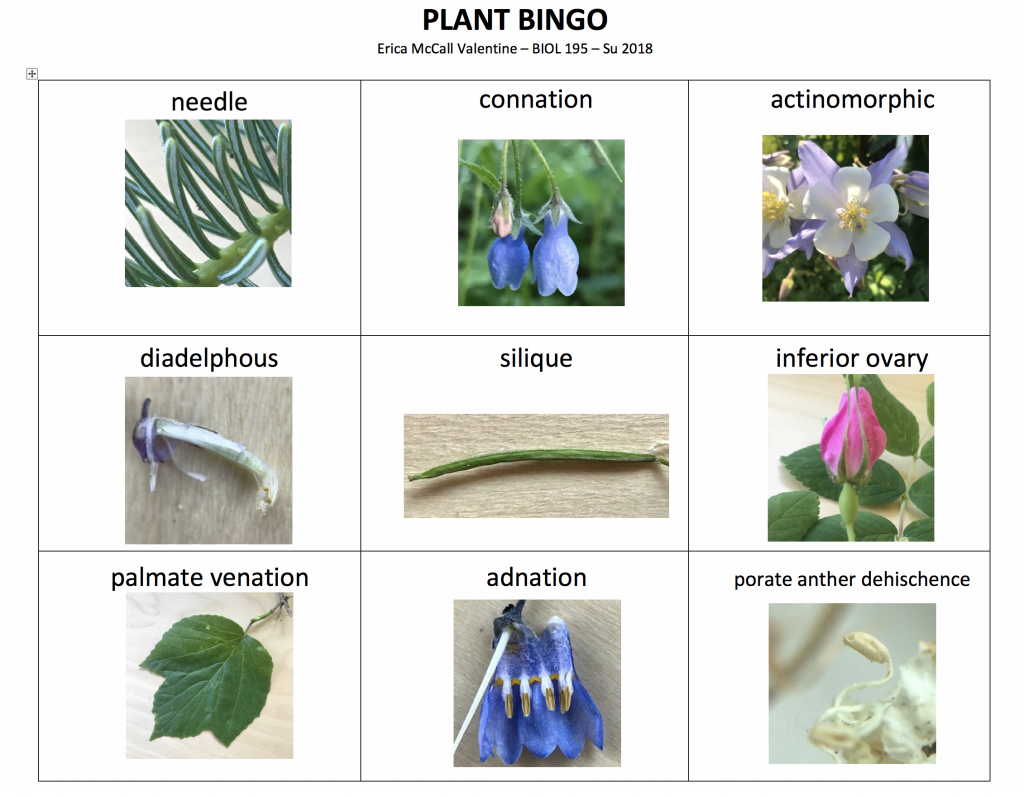UPDATED 6/24/2018:
This was a fun assignment. I found most examples to fill the ‘bingo card’ around our home in Fairbanks. I was stumped in finding an example of silique near our house to fill the middle square. Today I found a silique near the University of Alaska Fairbanks’ Comunity Garden. The porate anther dehischence was hard to capture due to its teeny size. I learned that using my loupe at 20-power in front of my iPhone camera zooms in much more than the clip-on macro lens purchased thorugh amazon.com. It’s just a bit tricky to hold in one hand at the right distance and zoom in and capture the image with the other but, it works.
Thank you for the feedback on the porate anther dehischece. Orignally I included a photograph of an anther from a Mertensia paniculata (Aiton) G. Don var. paniculata but with Steffi’s feedback I went out and searched again. I found what I was looking for in Ledum groenlandicum Oeder! I’ve updated my bingo card (Image 1). The new one is above the original (Image 2).
And, when tromping about in the woods near our house, I also discovered about 40-50 spottled lady’s slippers (Cypripedium guttatum Sw. var. alaskanum), which was pretty exciting. I’ve incuded a picture of one below the assignment (Image 3). ~ Erica
Image 1: Revised Bingo Card – porate anther dehischense corrected.

Image 2: Orignal Bingo Card – porate anther dehischence is incorrect

Image 3: Spotted Lady’s Slipper (Cypripedium guttatum Sw. var. guttatum)



Awesome, those are great pictures! Well done. Your image of porate anther dehiscence looks like it might be longitudinal anther dehiscence? Which plant did you use for it? Mostly it can be found in Ericaceae, but Solanaceae also show this condition. Most plants have longitudinal anther dehiscence, where the anthers splits along its length to release the pollen, but some families have porate anther dehiscence, often this is associated with buzz pollination (the vibration of the bees wings releases the pollen and as a result the bee is covered in pollen).
Yes, you could probably make some kind of holder for the loupe and attach it to your smartphone and get pretty good results.
Found porate anther dehiscene & updated my card and posting! Again, thanks for the feedback!
Thanks for the feedback! The porate anther dehiscence square is from Mertensia paniculata (Aiton) G. Don var. paniculata. I struggled a bit in completing this square since this was my first time really looking for this and I wasn’t 100% on what I was seeing. Here was my process in id’ing: I compared it to an anther from Fuchsia L. and the longitudinal anther dehiscence was pretty obvious on that one as comapred to the bluebells. Knowing that bluebells are pollenated by bees and I could only see pollen grains at the one point on the anther, I assumed porate. I’ll go look to see if any of the Pyrola nearby have blossomed (they were still closed last night) or gather some of the blooming Rhododendrons I saw when driving home from a friend’s house last night. Since they’re both in the Ericaceae family perhaps I’ll find an example of porate anther dehiscence there…. I’ll post what I find. Thanks!
Wow, gorgeous photo. You have a great eye, Laura
That is a beautiful flower! I’m so happy you shared it. And great job on your bingo card!
Thanks Erica,
yes, this is a good one for porate anther dehiscence! Well done, thanks for going the extra mile for replacing that one, best, Steffi.